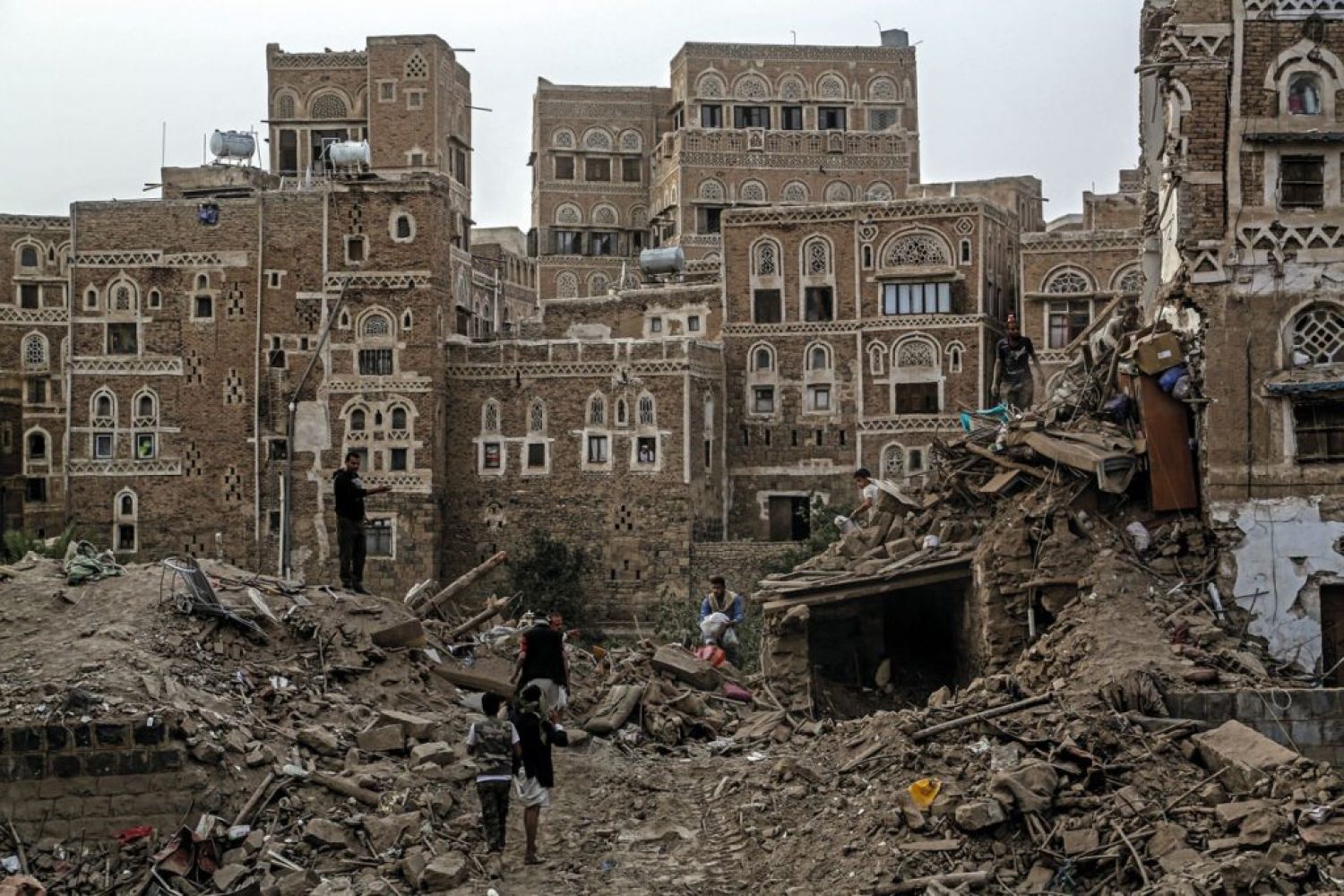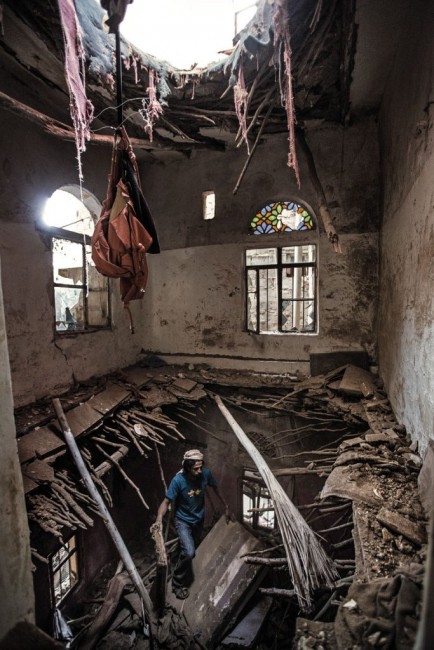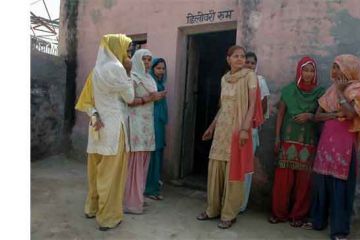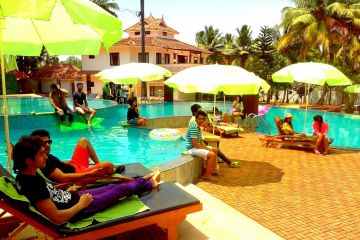
On November 4, Yemen’s
Houthi rebels fired a rocket aimed at Riyadh, Saudi Arabia’s capital. It
was an audacious move—the rebels had shown that they were willing to inflict
mass civilian deaths inside Saudi Arabia. It also showed that the Houthi rebels
had weapons that could target Riyadh. The rocket was shot down outside the city
by Saudi forces using American-made Patriot surface-to-air missiles. The timing
of the Houthi attack couldn’t be more significant. Around the same time Saudi
Crown Prince Mohammad bin Salman had ordered the arrest of 11 princes of the
house of Saud including those holding defence portfolios and the billionaire
investor Prince Alwaleed bin Talal for corruption. Prince Salman was the
architect behind the Saudi-led coalition force that was engaged in battle in
Yemen. As he conducted the purge, his country blamed Iran for empowering the
Houthis. For Yemen, a country that has seen only war and death since 2015, it
was just another day as the Arabian Peninsula’s latest battleground.
In Haidan no stone was
without the scar of war. A town along the Yemen-Saudi Arabia border, Haidan’s
people had started living in caves, cracks in the mountain their only refuge.
While death stalked people, Nagda, the sole midwife in Haidan, went about
bringing new life. Inside caves, in darkness, she delivered babies. Her kitchen
knife cut umbilical cords. The war couldn’t stop her.
“Life doesn’t wait for
anybody,” she would tell her husband.
“Nor does death,” he
would argue.
Nagda travelled across
three districts in Saada to help women. As the attacks there intensified,
hospitals and clinics became targets. Each house in each village had its tale
of tragedy. She knew of farmers blown to bits by cluster bombs when they took
their sheep to graze. An airstrike in Saada had killed 47 people of whom 26
were children.
It was as though the
Saudi-led coalition forces wanted to cleanse the rebel heartland of its people.
Nagda got pregnant but continued to work. Often people paid her in food but
most paid her with duas. When she went into labour, her husband ran
from house to house for help. He didn’t get any. Nagda died giving birth.
Her husband named their
daughter Eman, because that’s all he was left with: Faith.
Mediaeval Arabs used
to say “In Yemen, there is wisdom”. It is one of the oldest centres of
civilisation in the Middle East and its capital Sana’a has been inhabited for
more than 2,500 years. Yemen is the poor tip of the Arabian Peninsula, bordered
by oil-rich Saudi Arabia and Oman in the north and across the Red Sea from
Ethiopia. It is mountainous and arid, its interior a maze of mud skyscrapers,
hill towns and wadis. Yemenis live in skyline villages, isolated and protected,
teetering above fertile valleys.
Once known as Arabia
Felix, or Happy Arabia, Yemen’s fortunes have fallen. Competing tribes,
secessionist movements, civil wars and corrupt governance have made Yemen the
poorest country in the Middle East. Since 2015, the country has been the site
of a civil war where old foes—former president Ali Abdullah Saleh and the
Northern Houthi rebels—have joined hands in a face-off against a US-backed
Saudi-led international coalition that supports exiled President Abd-Rabbu
Mansour Hadi. Adding to this is the simmering Sunni-Shia rivalry between Saudi
Arabia and Iran, and the presence of jihadis. Yemen, also, has the second most
heavily armed citizenry in the world.
The war has claimed
over 10,000 lives and shows no signs of a slowdown. Forty-five per cent of
Yemen’s population goes to bed hungry, 20 million—eighty-two per cent of the
population—are reliant on aid, and over 2 million are internally displaced. It
is home to the world’s worst cholera outbreak as clean water is a luxury. On
cloudy days nothing works but the resilient Yemeni joke—at least we are a green
country. Civil servants haven’t been paid in months, only 45 per cent of
hospitals are operational, and only 30 per cent of the required medical
supplies get in. Currently, a child under the age of five dies every 10 minutes
of preventable causes. The UN estimates that the country requires $2.1 billion
in humanitarian aid this year. The largest donors, America, Saudi Arabia, Great
Britain and the United Arab Emirates, are the main actors in the war.
Abdo was a
sea-hardened sailor and Raghda a Western-educated reporter. He used to
smuggle khat and migrants, she used to travel across Yemen
speaking to tribesmen. They met one night under a bomb-lit sky. Hundreds had
gathered at al-Boraika port in Aden, Yemen’s main port city, and waved $100
bills, determined to leave a city where the dead were piling up on the streets.
She waited to board his boat in May 2015.

A hollowed out house after an explosion in Sana'a in April 2015. Photo: (This and title image): Ameen Alghabri
A woman with seven
children was hysterical because she’d left her husband, a family of Syrian
beggars and a broke Indian nurse pleaded for a free ride while Yemenis with
British or American passports elbowed ahead. Above, Saudi jets circled the sky
in a relentless air campaign against the Houthi rebels. American and
British-made bombs hit military installations, homes and markets. Snipers from
the Houthi-Saleh alliance competed with militias and loyalist soldiers
associated with Hadi. This was a free-for-all: extremists from al-Qaeda and
hardline armed Salafis joined the cacophony.
The port was part of
the frontline and had already been targeted. The passengers piled on top of
each other and when they couldn’t, they simply knelt. Abdo let her sit in his
rat-infested cabin and set sail for Djibouti.
Over the 26-hour
journey across the Red Sea he spoke about his home in Hodeida, a port on the
Red Sea. It had fallen to the rebels, on October 2014, who had lined the shore
with mines fearing a coalition invasion. He reminisced of simpler days when the
only nuisance was Somali pirates lusting after khat. Fishermen had
become suspects now and were often accused of carrying arms sent by the Iranians.
Foreign navies soon began appearing at sea. That night the sea was calm. By the
morning the calm was shattered when two elderly women were found dead. Couple
of hours later a seven year-old-boy died of an asthma attack.
“The sea is a form of
suicide,” he told her as they parted ways.
On the night of March
26, 2015 F-15s and F-16s from Saudi Arabia headed for Yemen. They were later
joined by a nine-country Arabian and African coalition led by Saudi Arabia. The
stated aims of Operation Decisive Storm are to reinstate Hadi and repel the
Houthi Zaydis.
The Zaydis emerged
following Zay’d, the fifth Imam’s uprising against the Ummayah Caliph in 724
CE. Under the Mutawakkilite Kingdon, they ruled North Yemen from 1918 until
1962. It was only under Ali Abdullah Saleh in 1978 that a nationalist and
leftist army ushered Yemen into the modern age, severing all ties with
the theocratic elite. “Zaydis are often referred to as the Sunnis of the
Shia and the Shia of the Sunnis,” says Waleed Mahdi, Professor of US-Arab
Cultural Politics at University of Oklahoma. Even in Saleh’s rule, Houthis
continued to hold important political and military positions in Yemen.
Modern-day Zaydism
started as a grassroots revivalist movement opposed to what was perceived as
Saudi-backed Salafi expansion in north Yemen. It morphed into a militia under
the leadership of Hussein al-Houthi who was killed in the first round of
fighting in 2004. The current leader of the Houthis, Abdul-Malik al-Houthi is
both a military man and a Zaydi preacher.
The Houthis are
battle-hardened guerrillas who fought Saleh in a low-level insurgency from 2004
to 2010. The Houthis were present in large numbers at Change Square in
the days of the “Arab Spring” when Yemenis demanded the ouster of Saleh in
2011. After he resigned, they participated in the national dialogue but as the
political transition faltered, the Houthis reverted to arms. They stormed the
capital, Sana’a, in September 2014. A few months later they ousted Hadi, who
fled to Aden. Abdel Malek appeared on TV after the bloodless coup and spoke of
a second revolution in Yemen: “Yemenis will not allow despots to rule the
country again,” he said. His focus was not military but the restoration of fuel
subsidies and economic reform.
Their unlikely ally
has been their former enemy, Saleh. He saw in the Houthis—strong fighters but
poor administrators—an opportunity for revenge on those who turned on him in
2011. Saleh has lorded over Yemeni politics with a unique blend of savvy
and thuggishness since 1978. His 33- year rule has seen every institution
gutted. But Saleh is a rare figure: a dictator overthrown by popular revolt who
manages to remain in his country, unmolested.
Hadi is not without
criticism. Weak and ineffectual, he never enjoyed genuine support among
politicians or the army. He was elected to power for two years on February 21,
2012 in what was a one-candidate election. Many Yemenis view his presidency as
illegal. He rules from exile in Riyadh while a faction of his
internationally-recognised government is based in Aden.
When Mazen, a
conservationist, was a boy his grandfather would tell him that Aden, built on
the crater of an ancient volcano, was as old as human history itself. Local
legends claim the city was founded by Cain and Abel. When his grandfather
arrived from in Aden India, Arabic songs were sung to Indian music and new
residents assimilated into Indian neighbourhoods. He called it “a city of
tolerance”.
Temples stood next to
churches, Zoroastrians worshipped at the Fire Temple, and synagogues were
accommodated. In 1948 things started to change: Jews were the first to move
out, temples began boarding up their doors and the church bells stopped
chiming. “Preserving ancient sites will be important for the future,” Mazen’s
grandfather would tell him. Dark days were coming, he warned as al-Qaeda reared
its ugly face with bombings and assassinations. By 2011, al-Qaeda capitalised
on post-Arab Spring chaos and settled in the southern provinces.
Five days after Hadi
promised to raise Yemen’s flag on Mount Marran in Saada, the Houthi heartland,
he abandoned his heavily guarded palace in Aden. The advancing Houthi rebels
offered a bounty of $93,000 for the president’s capture on state television
while Hadi was seen pleading for assistance to the UN, to the Arab League.
There were rumours that he had dashed across the waters to Oman or Djibouti and
onwards to Saudi Arabia.
The Houthis took their
positions around the mountains. They hid in forts, around 500-year-old walls in
the Husseini Mosque. Three men camped in the mosque. Mazen asked them to leave.
Not far from the mosque, a group of about 10 men had entered the military
museum. It was an old British colonial building. He looked around and couldn’t
see weapons anywhere.
Then the coalition
attacked. They flattened the mosque leaving just one minaret standing, knocked
down the side façade of the museum. In the chaos of war, religious fanatics,
al-Qaeda and hardline Salafis were determined to wipe out what they consider
idolatry. The statue of Mary on the Saint Joseph Church was destroyed and Mazen
appealed to the governor to protect antiquities. No one listened.
Clean water is a luxury in Yemen. The country is the site for the
world's worst cholera outbreak brought about by the war. Photo: Eman al-Awami.
So a group of friends
began collecting valuables from the church. A few weeks later, it was set on
fire by extremists. They now have in their possession Ottoman weapons and
parchments and are keen to return it to their rightful owners.
“When the Christians
return I will give it to them,” he says.
What about the
government? I asked.
“We don’t believe in
this government,” he said. “The flag of the independent South flies all over
South Yemen, nobody believes in the legitimacy of Hadi. The only place he can fly
the unified flag of Yemen is in his bathroom.”
Hadi rules in exile
from Riyadh.
Saudi Arabia has no
clear endgame beyond putting Hadi back in power, securing its borders with
Yemen and checking Iran’s power in the region. It assumed that given the size
and sophistication of its air force and the prowess of Emirati ground troops,
this would be a short war. They miscalculated badly.
Behind the Saudi-led
misadventure in Yemen is Mohammad bin Salman, known popularly as MBS, the new
Saudi crown prince. At 32, he is seen as a long-awaited young reformer with the
potential to shake up the world’s most autocratic society, or as an impetuous
and inexperienced princeling. The war in Yemen can be seen as an attempt to
bolster his standing. Should he succeed and expand the Wahhabi dawah,
Saudi’s religious beliefs, southwards he could legitimise himself in the eyes
of the ulama, the traditional kingmakers.
But the war is being
called Saudi Arabia’s Vietnam, according to experts. In a leaked email obtained
by the online news site Middle East Eye in 2017, the crown prince wrote to
Martin Indyk, former US ambassador to Israel, and Stephen Hadly, former US
national security adviser saying, “I don’t care who wins, I want it to end.”
Meanwhile, a UN panel investigating 10 air strikes by the coalition—in which at
least 292 civilians were killed—found that most were the result of an
“ineffective targeting process” or deliberate attacks on peaceful targets. The
63-page report (2017) claims that the “panel considers it almost certain that
the coalition did not meet international humanitarian law requirements of
proportionality and precautions in attack.” The panel considers that some of
the attacks may amount to war crimes.
“The war in Yemen has
produced 3.15 million internally displaced persons. Although the United States
government has provided most of the bombs and is deeply involved in the conduct
of the war, reportage on the war in English is conspicuously rare,” wrote
Julian Assange when WikiLeaks released the Saudi Cables. Journalists have been
denied access to cover the war. Recently the coalition blocked BBC journalists
from travelling to Sanaa.
The Saudi Cables
reveal the extent to which Saudi Arabia goes to monitor and co-opt Arab media.
It is meticulous in ensuring that the right message is presented on Saudi
Arabia and Saudi-related matters. The policy is “neutralisation” and
“containment”. A “neutralised” journalist or media institution is one whose
silence and co-operation has been bought. “Containment” consists of active
propaganda where journalists and media are not only required to peddle the
kingdom’s line but also lead attacks on critics.
The Houthis are no
saints. When they took Sana’a in 2014, they shelled Yemen State TV and replaced
media professionals with Houthi-affiliated media groups. The rebels used two
Yemeni journalists as human shields while investigative journalist Mohammed
al-Absi, known for reporting on a number of Houthi-related-corruption stories,
was poisoned. A Houthi-controlled court issued a death sentence against
journalist Yahya al-Joubayhy for being a “Saudi spy”.
The young leader of
the Houthis, Abdul-Malik al-Houthi warned in 2016: “The media are more
dangerous to our country than the nationalist and warring mercenaries.”
Facebook, Twitter and
YouTube are the frontlines of this battlefield. Yemen is often referred to as
the “forgotten war” because of lack of media coverage. However, even with the
destruction of infrastructure, patchy cellular networks remain operational, and
the Internet was never switched off the forces. Even as media found it
difficult to enter Yemen, the activists and witnesses inside have continued to
put out images and updates on the Web. Leading Yemen’s twitterati is
Hisham al-Omeisy who was picked up on August 12 by the Houthis and
has hasn't been heard since.
In a country where
Kalashnikovs are fired at weddings and grenades thrown in joy, when the war
arrived, Ammar’s neighbour calmed petrified children by telling them it was
just a “celebration”. With no electricity, Sana’a was covered in darkness. From
the balcony, they’d watch the tracer shells from WWII era anti-aircraft guns
light up the darkness. Often the shells would crash down or spray small metal
shards. They seldom reached the target, the Saudi F15s. The bombers would
target at random: military installations and homes, chicken farms and
mountains. No one was safe. Ammar, a film maker, had settled into a nervous
rhythm and on October 6, 2016, while he chewed khat with
friends in the afternoon, he heard a massive explosion, and then another.
Their phones began to
beep and ring.
The Al-Kobra Grand
Hall had been hit while mourners gathered for the funeral of the Minister of
Interior’s father. “It’s a mess,” he was told. Mourners had been trapped as
chandeliers, air-conditioners and the ceiling caved in. Many were buried in the
rubble. Under the hall were the guards with RPGs. These exploded. The Grand
Hall went up in flames fast.
Videos began to stream
into his Facebook feed. People were taking pictures with their mobiles and he
was seeing chopped hands, a brain spilt on the ground. State TV didn’t censor
anything. Hadi’s channel didn’t censor anything. “Day after day, they’d show
horrible images,” he says. He’d hear people talk; someone found a hand in the garden
or a head on the roof.
He decided to make a
movie about the attack. “It’s my work of art not to show blood,” he says.
Instead he spoke to families: to a young woman, a dentist who had just given
birth and refused to believe her husband died. They haven’t found his body. To
a 10 year-old who was protected by his father’s dead body. BBC was on the scene
in a rare appearance. Its segment concluded by confirming that the missile
responsible was American and not British. On the seventh day he completed The
Great Crime, of Saudi war crimes in his city.
The attack on the
funeral shook the international community. Initially, Saudi Arabia denied that
jets from the coalition had been involved. But in a later statement “about the
regrettable and painful bombing,” it accepted responsibility. The statement
claimed that the attack which killed at least 140 people was based on “wrong
information” provided by an unnamed party.
The US responded
quickly. The National Security Council conducted an “immediate review” of its
support for the coalition, claiming that “US security cooperation with Saudi
Arabia is not a blank check”. America is crucial to Saudi Arabia’s mission: not
only does it provide arms and logistical support but provides mid-air
refuelling for Saudi warplanes. Without this, they would not be able to bomb
Yemen. On June 13, a resolution to stop the sale of precision guarded munitions
to Saudi Arabia was defeated by a 53-47 vote in the Senate.
The United Kingdom too
is heavily invested in this war. Immediately after the strike at the funeral,
the UK said it would present a draft resolution to the UN Security Council
which calls for an immediate ceasefire. An earlier draft was rejected by Russia
for not being strong enough. The new resolution would counter resolution 2216
that remains the key Security Council decision on Yemen. But the new draft was
never circulated, apparently after pressure from Saudi Arabia.
Amnesty International
has accused the US and UK of covering for Saudi Arabia. “They have received
political support, logistical support, intelligence support and the provision
of weaponry from the key allies the US and UK,” says James Lynch, Deputy
Director of Global Issue. Since the attack on the funeral, the
UK and US have increased arms export to Saudi Arabia during this conflict. In
May 2017, President Trump signed an arms deal with Saudi Arabia worth $10
billion on what he described as a tremendous day. He called the bombs
“beautiful.” Six months after the funeral strike, the British government
approved a £283-million arms sale to Saudi Arabia. This includes combat
aircraft components to the Saudi air force, bombs and missiles. New research by
War Child UK found that British arms companies have earned more than £6 billion
from trade with the Saudis during the war in Yemen.
Murad began weaving a
narrative even before a bulldozer threw up dust as it cleared rubble from
Sana’a’s streets. The façade of the building had been torn and all that
remained was a wall. He drew a yellow hourglass but instead of sand he painted
skulls.
Concrete, brick and
stone skirted a classroom; a tree had collapsed next to a yellow desk in the
courtyard of the school. On a wall he drew a mural of a child with a grenade
instead of a textbook in his hand. His work appeared across Sana’a, it combined
artistic expression with social and political commentary in a country where
journalists were under lock and key.
He wanted to get into
Taiz, a city under siege. He rented a car and travelled with a woman friend, a
photographer. If the Houthi rebels thought they were family they were less
likely to be stopped across the many checkpoints. They left Sana’a at 3 a.m.
They wanted to get back after sunset on the same day. They took the long road
because they had no other option. A four-hour journey took them 19 hours. They
drove past bombed out villages and across cities like Dhamar where it seemed as
though no building was left unbombed. On the road to Ibb a crucial bridge had
been blown up. They took another route and drove through a small river.
Taiz, the cultural
heart of Yemen, is a city on its knees under a Houthi siege. Women smuggle
medicines under their burqas, cars are prohibited from the ring road and
donkeys ply over mountains with essential supplies. Murad wanted to target
areas that were destroyed. It was impossible to get in, so he went as far as he
could. He painted on a rusted pipe in the al-hwban area. A picture of a young
girl in a dress watering a rose that grew out of a mortar.
He tried to keep
working. The three art shops of Sana’a remained open. But during war, he said,
“It is not one of the important things to care about.” The embargo, the
blockade, the siege meant that there was a 100-150 per cent increase in prices.
A 5 ml pot of colour used to cost 850 rial and now costs 1700 rial. It’s been
four months since he’s made anything. He needs to sell paintings that will
support his work on the streets. He doesn’t want anyone to pay for that, he
doesn’t want to affect the message’s honesty.
Parts of the country
are rubble. Rather than moving towards dialogue, the coalition and allied
fighters have opened a new front in Saada, the Houthi heartland. Over the past
decades both Saudi Arabia and Saleh sponsored Salafi-Wahhabi madrassas and used
Sunni Islamists for political goals. The aim was to weaken the Zaydi elite. The
attack began on Ashura began in October 2016. Border towns was taken by
coalition fighters despite the stiff resistance from the Houthi forces. They
moved towards Kutaf, once a site for a popular Salafi madrasa and centre for
anti-Shia agitation. Members of Yemen’s Wa’ila tribe, some of whom have adopted
the Saudi brand of Salafi-Wahhabism, offered the Saudi-allied fighters shelter.
Soon the mercenaries, the “Afghan-Arabs” arrived on the scene. There is footage
on YouTube which shows AQAP fighters fighting alongside the coalition forces.
The Wa’ila who had
fought wars with the Houthis saw this as a moment to exact revenge and have
integrated with Saudi-paid Sudanese fighters in the offensive against
Saada which was under Houthi control since March 2017. The Houthis have not
suffered in silence: They have fired Katyusha rockets on a Saudi army
stronghold in Jizan. In an intense battle four cars came to a military position
and carried off the bodies of four soldiers while Saudi soldiers pulled the
bodies of their wounded men. Later in the month, the Houthi snipers killed six
Saudi soldiers in Jizan. In June 7 Saudi soldiers were shot at the Alab crossing.
The Saudi offensive, however, was met with stiff resistance. Politically this
is headed for disaster since Hadi has appointed a Wa’ila tribesman, Hadi
Tirshan al-Wa’ili, a dedicated Salafi, as governor of Saada.
On May 7, the
coalition dropped leaflets warning Saada residents to leave. Ten days later, UN
satellites showed that a total of 1,171 structures in Saada city had been
damaged or destroyed by air strikes.
There’s no water in
the pipes. Electricity was cut on day one of the war. More than 350 trucks with
wheat flour, sugar and salt were hit while delivering aid. Most villages on the
border have been destroyed and the toll in Saada stands at 3,000 civilians.
This is the frontline of the war where Saada’s famed grape farms are targets.
More than 50 farms were attacked by airstrikes in one go. Ninety per cent of
the population here is displaced.
“The Yemeni flag has
never left Marran,” says Loai who works with internally displaced persons. “But
unfortunately Hadi flies the the KSA and UAE in Aden and not the Yemeni.”
The Houthis retaliate
with long-range rocket strikes and cross-border raids into Saudi Arabia. These
have grown more powerful since late May 2017. The arsenal supposedly has BM-21
and BM-27 multiple rocket launchers and advanced Iranian-supplied anti-tank
systems such as the Metis-M, Kornet-E, and RPG-29. Saudi homes are pockmarked
with shrapnel. Missiles fired by Houthi rebels land in the towns of Najran and
Gizan and have the power to reach Makkah according to Saudi Arabia. Between June
6, 2015 and November 26, the Saudi authorities counted 37 missiles fired from
Yemen into their territory.
In 2013 after Yemen
averted a civil war, a Facebook post announced the setting up of a book club at
Sana’a’s Coffee Corner. It became a place for heated discussions, got invited
by the US embassy, and its fame reached the hinterland. Bashir from Dhamar
travelled 100 km to attend the weekly meetings.
In 2014, the book club
met at Dhamar’s Bardouni Library, named after Yemen’s most famous poet. They
read Love in the Time of Cholera by Gabriel Garcias Marquez.
Clouds of war engulfed the country.
In 2015, the war
rained down. Sana’a was bombed day and night; a bomb exploded next to Coffee
Corner, which was badly hit. On May 27, a military camp near the Bardouni
library in Dhamar was bombed. The windows of the library shattered and the
nearby museum that housed 12,500 artefacts, the oldest dating to about 10,000
BCE was flattened.
By 2016, most book
club members had fled the country. For those who remain, life is hard. Wages
aren’t paid; many flee to the countryside. The airport at Sana’a is shut. Books
no longer come in. Over the months, the Bardouni library fixed its windows, and
a depleted book club reassembled. “Everyone is frustrated,” says Bashir, the
organiser.
In 2017, a country of
killing fields, rubble and starvation remains. In Taiz, another book club run
by al-Qaeda in the Arabian Peninsula is set up. The book they read is
titled This is Our Message, an al-Qaeda manifesto, and members are
invited to join a contest to summarise it in 30 pages. The first place
submission gets a brand new Chinese-made automatic rifle, the second place a
motorcycle, third place a pistol, fourth place a laptop with mobile phones and
cash prizes for the other winners.
The coalition’s
targeting of weapons storage facilities in areas controlled by the Houthi-Saleh
forces has contributed to the scattering of military equipment. Saudi Arabia
has played a role in weapons proliferation by supplying arms to militant groups
without ensuring accountability. There is footage of weapons airdropped into
Aden, which have ended up in the hands of extremists. In Taiz, armoured
vehicles similar to those used by the opposition are being used by resistance
fighters affiliated to a Salafist group called the “Emirate of Protectors of
the Creed.”
America has tolerated
this, despite its aim being the defeat of the very people it indirectly is
arming. In the January 2017 raid the US targeted and killed AQAP tribal leader
Sheikh Abdel Raoud al-Dhahab. In the lead up to the US raid, al-Dhahab was in a
meeting with Hadi’s military chief of staff where he was paid $60,000 to join
Hadi’s fight against the Houthis.There is a black market for weapons and
resistance fighters offer to sell small arms and light weapons on social media.
Armed Salafists have
been mobilsed in resistance-held urban areas like Aden and Taiz. Salafist
preachers use mosques and Friday sermons to galvanise and mobilise local
supporters. AQAP has used the pretext of Sunni defence against the Shia Houthis
to blend with local tribes and Salafi sympathisers and get access to weapons.
In November 2014, ISIS
entered the Yemeni jihadi sphere through a tweet pledging allegiance to
al-Baghdadi. Competition between al-Qaeda and ISIS is building up. ISIS has
claimed responsibility for more than 20 operations in Aden, Bayda, Dhamar and
Sana’a. In March the group killed 140 people in a double suicide bombing in
Sana’a in two mosques used mainly by supporters of the Houthi rebels. In October
they targeted government ministers and coalition forces at the Qasr hotel in
Aden. In December they killed the Governor of Aden, Major General Jaafar
Moahmmmed Saad, in a car bombing. But AQAP is still stronger than ISIS.
A 2017 UN report
states, “Terrorist groups such as Al-Qaida in the Arabian Peninsula (AQAP) and
the Islamic State in Iraq and the Levant (ISIL) affiliate in Yemen are now
actively exploiting the changing political environment and governance vacuums
to recruit new members and stage new attacks and are laying the foundation for
terrorist networks that may last for years.”
Abdel Latif, a coffee
merchant, spoke of an ancient Yemen, of villages perched on mountain tops and
boxy mud brick houses etched with white filigree. The locals spoke of a Sufi
saint from 1450 who drank a magical potion, a chocolaty, dark, thick syrup and
was able to pray deep into the night. Coffee. Soon its trees began to transform
the mountains, terraced hillsides thrived as farmers invented new techniques.
If Ethiopia was the source of coffee, Yemen was instrumental in bringing coffee
to the world through a port called Mokha. The Dutch East Indies Company used
Mokha as a bridge between Ethiopia and India and brought coffee cultivation to
Indonesia. Coffee from Mokha made its way to destination further west, to the
island of Martinique and Central America.
Over time government
neglect saw the fortunes of Mokha fall while the famed mocha coffee made way
for the more lucrative khat trade. But since the beginning of
the war, something has been changing in the valleys. Civil servants who hadn’t
been paid for months were returning to their villages and old plantations were
back in action. General Suleiman, a career officer from Saleh’s army had been
trained in Europe and the US. After a three-decade career in the army and
months with no salary, he quit at 50 and returned to his ancestral farm. He
planted 5,000 coffee trees this season and was preparing to plant another 5,000
for the next, transforming the village in Anis.
“It is so magical
here,” he said. “The war is far from these villages. They are still as they
were.”
But the war made
itself felt: the blockade meant bags imported from India and America, necessary
to pack the coffee, were slow to arrive. A web of checkpoints from Sana’a to
Aden hiked transport costs, a journey that would ordinarily take six hours took
12. The delays affected the quality of the coffee. But when the Mocha Haima was
brought to the market, it was divine and sold for $280 per kg in Sana’a
governorate. This caught the attention of some farmers and thus began Latif’s
goal: to replace khat with coffee, to revive Mokha and its
coffee.
When he heard about
the attack on the port of Mokha, he recited a quote: “But man is not made for
defeat. A man can be destroyed but not defeated,” from Ernest Hemingway’s Old
Man and the Sea.
The Gate of Tears or
the Bab al Mandeb is strait between the horn of Africa and the Middle East.
With Yemen on one side and Djibouti on the other, it is a chokepoint, a narrow
but vital waterway, essential for international maritime trade between Europe
and Asia. It links the Mediterranean Sea and Indian Ocean through which million
barrels of crude oil on supertankers navigate every day.
In October 2016, the
Spanish-flagged merchant tanker Galicia Spirit was attacked by
a RPG fired from a small speedboat. Two days later, the liquefied natural gas
tanker Melati Satu was attacked in the same area, again with
RPGs. It was rescued by a Saudi Arabian naval vessel. Warships USS Mason and
USS Ponce, were attacked from the Yemen coastline and responded by
launching cruise missile strikes at targets in Yemen. It was only after the
attack on HSV-2 Swift, a UAE flagged vessel that was rendered
inoperable, that the Houthis claimed responsibility. In January, they attacked
a Saudi frigate killing two sailors. In May 2017 a small boat exploded in a
thwarted attack on a tanker, while in June an oil tanker came under the fire of
three rocket-propelled grenades. An international naval coalition is stepping
up its presence in response to what is believed to be Houthi attacks.
Hadi’s government and
the Saudi-led coalition accuse the rebel forces of using the ports to smuggle
arms from Iran and other suppliers. It is alleged that militias are using Zagar
and Hanish islands to smuggle weapons
Security Council
Resolution 2216 authorises the coalition to enforce an arms embargo against
Houthi forces and those loyal to Saleh but measures have gone too far. Ships
have been delayed for up to four weeks before receiving a permit to enter.
Ninety per cent of Yemen’s food and 8 per cent of its medical supplies are
imported. At the start of the war only 15 per cent of pre-crisis imports were
entering Yemen. As fuel for the generator at the main hospital began to run
out, the UN began warning about the risk of famine. There is talk of an
impending Saudi attack on the port of Hodeida. This next phase of war will make
the siege of Yemen complete and leaving its people with nowhere to flee.
(The cover story
of the October 2017 edition of Fountain
Ink)
(Update, Nov 6, 2017: The story has been edited to better reflect the changing situation in Yemen’s ongoing war.)





